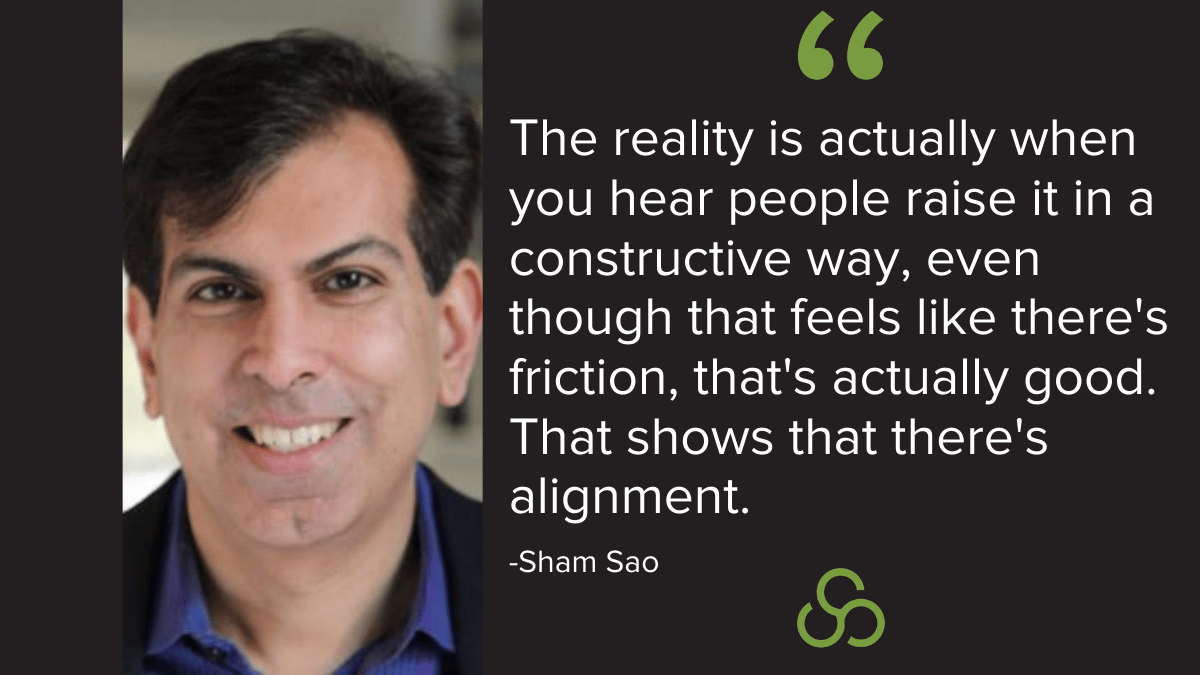
Even at just a high level, founders and executives need to be able to tell when alignment is and isn’t happening. If they see that alignment isn't working effectively, what can they do about it?
Check out what tips GM & Board Director for think-cell, Sham Sao, has about this.
Carole Mahoney:
So, when teams are doing this together they're going to stay aligned. And you've probably seen this. I've seen this.
At a high level, how does a founder, how does an executive tell when there's alignment happening and when there isn't alignment happening, and really what can they do about it as a first step?
Sham Sao:
Yeah, a lot of times the way the metrics are talked about is you can see in a meeting where there's metrics and there's holes in the way people are talking about it. Or marketing shows this really great chart of everything looking green and the sales numbers look like this. So when you see these just disjointed numbers that's a good clue.
Obviously when there's pure finger pointing, but a lot of people are nice enough where they don't get that rude in a meeting. They might go say it after the meeting's over or at the water cooler. It's actually better if they say it right at the meeting, but it's hard to be that blunt.
The reality is actually when you hear people raise it in a constructive way, even though that feels like there's friction, that's actually good. That shows that there's alignment. Some will say, "We had this batch of leads come in. The conversion seems to be lower on them." Especially if they're open to the fact that we should explore. Maybe we should be following up on them differently, but maybe we need to look them. If it's that kind of discussion it's really positive.
The other thing I think is really valuable is I really think it's important for these leaders to have real relationships with each other. So I had this instance once... This was actually between RevOps and Sales, where we had a new RevOps person in Sales and there was friction. They weren't getting along. And I basically said, "You guys need to go have beers together four times. And then after you go do that come back and tell me how it's going."
Carole Mahoney:
Yeah.
Sham Sao:
And you also, you can't talk just about work when you go do that. You need to go talk about other stuff and learn about each other and then talk about work. They just weren't meshing well together. But when they really got to know each other and... They worked a little differently. Once they saw, oh, you work like this, I work like this, but we're both good people. And now we know it.
And the same thing, whether it's those two functions, whether it's sales or marketing, you've got to have that ability. And if you don't, it's going to be hard. I've seen situations where, for whatever reason, the personalities just don't click and you can't get them to click. If you can't really get them to at least be willing to connect with each other in that way, it does become difficult.
Carole Mahoney:
And it becomes difficult. It becomes toxic. It starts to spread throughout the teams. I've seen it happen myself. And I think it's really important too, as a leader, as a CEO, as a founder, to look at what is the emotional intelligence of our teams? What's the level of empathy? Those soft skills that we really need to develop now, I think just as much as ever.
And I also wonder if it also has to do a little bit with the culture that's in the organization. Like, do you have a true learning organization type of a culture where no one feels like they're being, they don't feel like they need to be defensive when they make a mistake. That they can be open and honest like, "You know what, we really messed this up but here's a way forward."
If you don't have the kind of culture that not just allows that, but actually encourages it, I think it's really going to be a strong battle uphill trying to align sales and marketing teams together.
Sham Sao:
Yeah, and I think that that holds true. That's a good one that holds across the company. And I've seen CEOs get better and better about this. I think in the past we had seen these cultures, and it still happens. I shouldn't say in the past. It was much more prevalent in the past. But these cultures where people would be afraid and freaked out about making a mistake. And they would hide data and all this kind of stuff.
And so I think it starts with the top to say, "Look, if you make a mistake and you come forward on it and are clean, that's okay. Everybody makes mistakes. If you make the same mistake 17 times we're probably going to need to talk." Probably less than 17, right? But if you keep making the same mistake over and over again, yeah, that probably isn't a great thing. But if you're being smart and you're making some mistakes, that's what happens to everybody, right?
Carole Mahoney:
Right. And that's what the whole theme of this season of what sales can learn from is all about, is about being able to not just learn from our mistakes, but the mistakes of others.
Want to learn more?
If you're interested in checking out more from What Sales Can Learn From Season Two, click below to access the links to each on-demand session. To learn more from Sham, make sure to follow him on LinkedIn!







